Have you ever wondered if our feline friends see the world in the same hues we do? When it comes to the spectrum of light, blue light is a particularly fascinating topic, both for humans and for our pet cats.
So, do cats like blue light?
Due to their unique vision, the way cats perceive this part of the spectrum is not just a matter of curiosity—it could also shed light on their behavior and preferences.
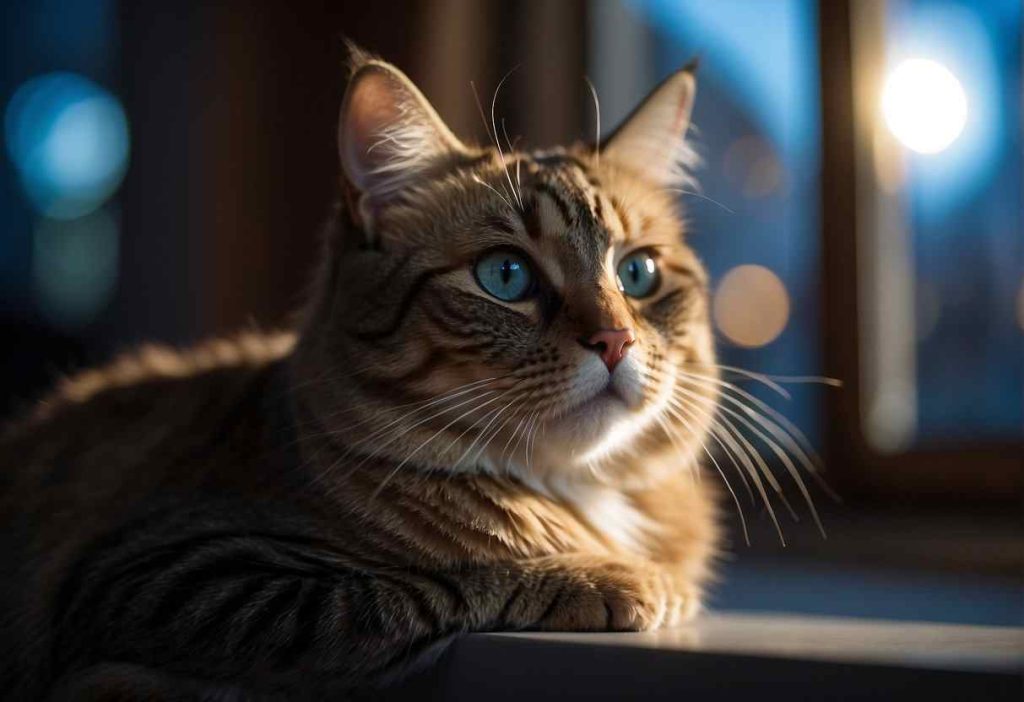
This article aims to satisfy your curiosity by exploring the intriguing relationship between cats and blue light.
We will dive into how cat vision works, discuss the effects of blue light on your cat, and investigate whether your cat may enjoy this color more than others. (1)
Plus, you’ll find practical tips on how to use this information to improve your cat’s happiness and health.
Let’s jump right in and illuminate the mysterious world of cats and blue light!
Key Takeaways
- Cats may have preferences for certain colors, including blue light, due to their unique vision.
- Understanding how blue light affects cats can help owners create a more comfortable environment.
- Practical guidelines for managing blue light exposure can enhance feline well-being.
Do Cats Like Blue Light: Understanding Cat Vision
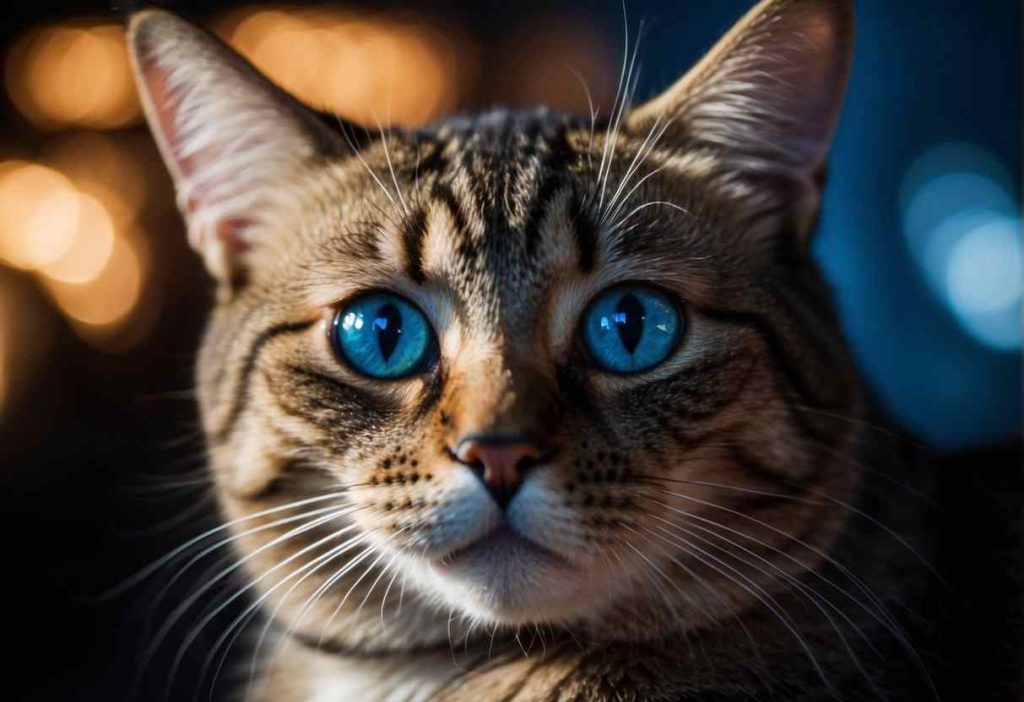
Cats possess fewer cone receptors in their eyes compared to humans, which means they perceive colors differently. (2)
While you might enjoy a rainbow of hues, cats are limited in their color range.
Their vision is similar to a human who is color blind to green and red, but they can see shades of blue and yellow fairly well.
Now, what’s the deal with blue light?
Research suggests that cats may have a specific inclination toward blue hues. (3)
This isn’t just about preference; it stems from their vision’s evolutionary design, which is tailored to detect shorter wavelength colors more effectively—like blue.
Curious about how cats distinguish between blue light and other colors?
When it comes to blue light versus, say, red or green, cats may react more noticeably.
This isn’t about a love for the color blue, but more about how well they can see it.
Think about it this way; if you were in a room where one object was much clearer than the others, wouldn’t you be drawn to it? That’s possibly how cats feel with blue light.
So, what do the experts have to say?
Vets and animal behaviorists conducted studies and noted that cats do show a measurable preference for blue light. It’s not just anecdote—it’s science!
Remember, don’t be fooled into thinking cats see the world just like you do; their unique vision shapes their preferences and behaviors in ways that continue to intrigue us.
Keep this in mind next time you spot your feline friend chasing after that little blue toy!
The Effects of Blue Light on Cats
Artificial blue light, predominantly from screens and LED lights, can influence your feline friend’s behavior and health. (4)
Health and Behavior Implications:
- Sleep Patterns: Cats tend to be crepuscular, meaning they’re most active during dusk and dawn. Exposure to blue light from gadgets late at night could disrupt this natural rhythm. It’s comparable to how we humans feel after a night of binge-watching our favorite shows—hello, restlessness!
- Behavior Changes: Too much screen time might result in a more lethargic or irritable kitty. Ever noticed your cat lounging for longer than usual or perhaps being a bit grumpier after you’ve spent the evening with the lights all ablaze? (5)
Addressing Common Concerns:
- Myth: Blue light causes permanent eye damage to cats. Fact: No evidence confirms this, but moderation is key.
- Myth: Cats are immune to the effects of blue light. Fact: Cats can be affected by light exposure similar to humans, so it’s best to limit it, especially at night.
Remember, while cats might not plop down for a Netflix marathon like we do, the ambient blue light around the home still counts.
Keep an eye on your furry friend’s behavior and perhaps trade some screen time for playtime to ensure they stay as sprightly and healthy as possible!
Enhancing Your Cat’s Well-being with Color
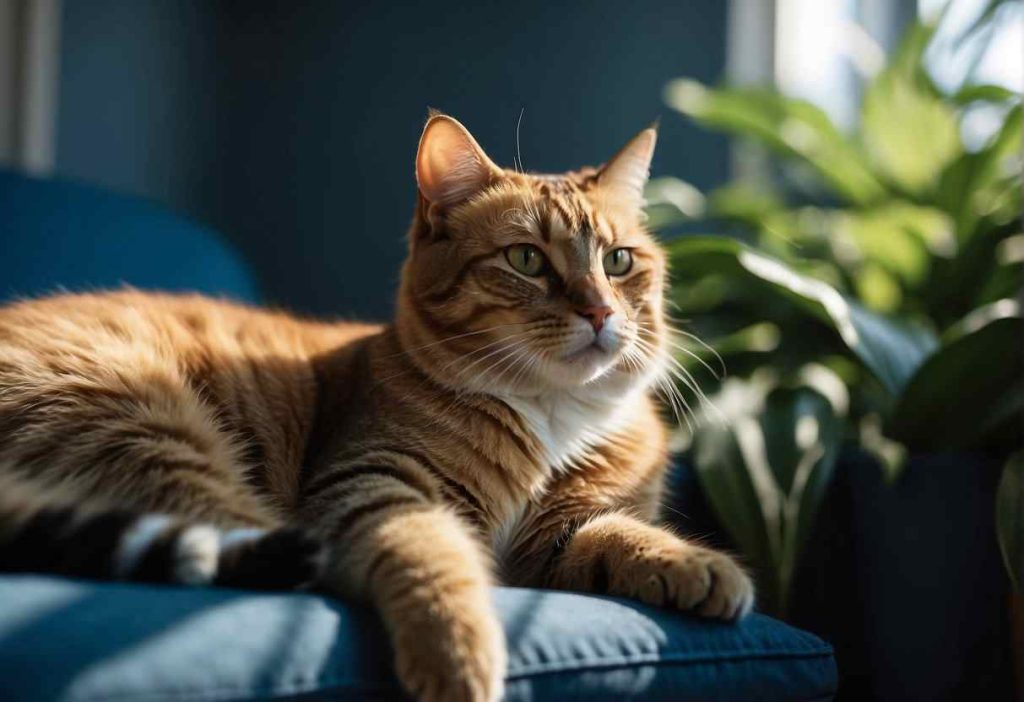
Color plays a pivotal role in your furry friend’s life, albeit a bit differently from humans. Let’s explore how the right hues can perk up your cat’s day!
Firstly, cats don’t see color the way we do, but that doesn’t mean their world is devoid of it.
Research suggests that cats see blues and yellows more vividly, while reds and greens might be less distinguishable.
So, choosing the right colors for their toys and environment can make a difference. Here’s a quick tip:
- Stick with blues and yellows to catch their eye!
In terms of toys, designers, and marketers, take note! It’s not just about attractiveness; it’s about functionality and engagement:
- Yellow and blue: These are the go-to colors. (6)
- Textures and shapes: Complement color choices with varied textures and shapes.
When accessorizing, not all cat collars or beds need to be fashion statements for your benefit.
Sometimes, it’s the simple patterns in the right shades that get those whiskers twitching.
Consider the following points:
- Play it Cool: Opt for cooler shades around the house to create a serene environment.
- Contrast is Key: Use contrasting colors for stimulation, especially in toys.
- Safety First: Always prioritize non-toxic dyes and materials.
Remember, your fluffy companion’s well-being can be enhanced by the thoughtful use of color.
It’s an easy way to stimulate their senses and add fun to their playtime.
So next time you’re picking out a new toy or accessory, keep these color tidbits in mind—your cat will thank you in purrs and play!
Practical Guidelines for Managing Blue Light Exposure
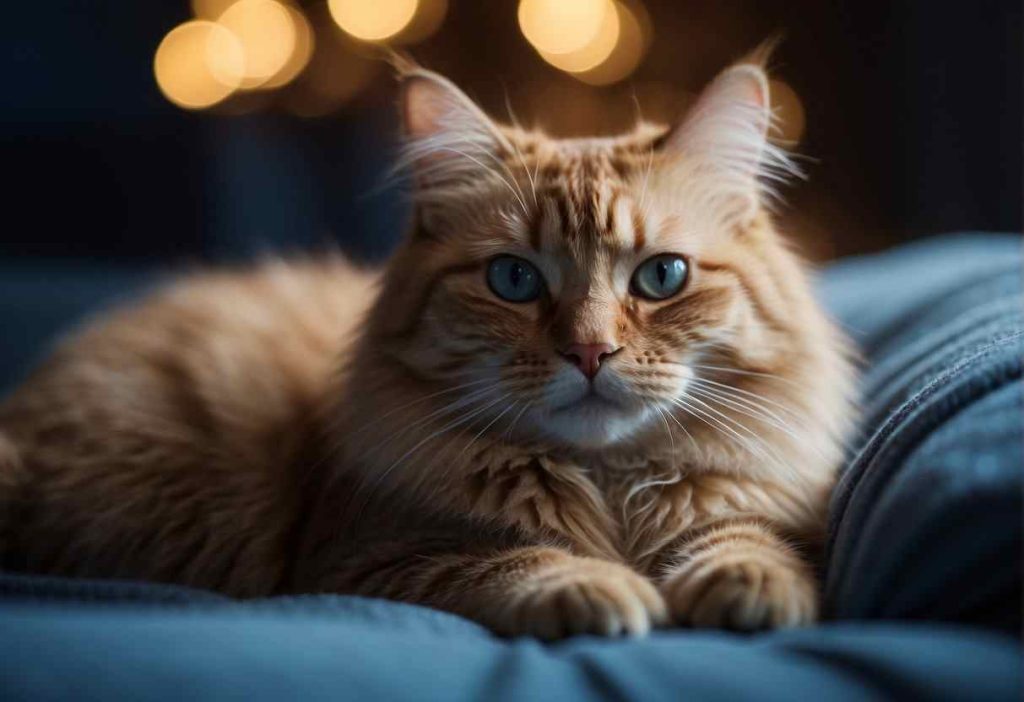
Cats are naturally attracted to movement and light, including blue light.
However, too much of it can be overwhelming for them. Here’s how to keep your kitty happy and healthy with the right blue light exposure. (7)
Creating a Cat-Friendly Lighting Environment:
- Avoid bright screens around cats, especially during their downtime. Your TV or computer screens emit blue light, and it’s best to keep your cat’s resting area away from these.
- Dim the lights as the evening rolls in. This mimics the natural day-to-night transition, keeping your cat’s internal clock in check.
Tips for Reducing Negative Blue Light Effects:
- Use ambient lighting that replicates daylight without the harshness of direct blue light.
- Consider blue light filters for screens if your cat tends to hang around while you binge-watch or work on the computer.
Selecting Pet Products for Optimal Color Engagement:
- Choose toys and accessories that engage your cat without unnecessary blue light. How about that mouse toy in a lovely shade of green?
Recommendations on Toys and Accessories:
- Curtains or shades to control the amount of natural light coming in.
- LED pet toys that emit minimal blue light, or better yet, toys without any light that encourage physical play.
Real-Life Stories and Case Studies

Testimonials from Cat Owners:
- “Mittens loves her blue light-up mouse toy, it’s like a magnet to her!”
- “I switched to a blue nightlight, and Whiskers seems calmer during bedtime.”
Did You Know? Cats can see certain colors vividly. Blue is often a hit!
Case Study #1: A tranquil kitty thanks to a blue hue.
- Name: Luna
- Change: The owner introduced blue LED lights
- Result: Luna’s midnight zoomies dropped by 70%.
Success with Blue Light:
- Strategy: Soft blue light therapy
- Outcomes for cats:
- Improved sleep patterns
- Less anxiety observed
Curious about giving it a try? Here’s what some folks did:
- Swap to blue toys and observe.
- Introduce a blue nightlight and note any differences.
With a blend of purrs and science, it seems blue can be the color of choice for our feline companions. But remember, each cat is unique, so what works for one might not work for another.
Keep an eye on your cat’s behavior, and maybe you’ll have your blue-tinted tale to tell!
Quick Recap
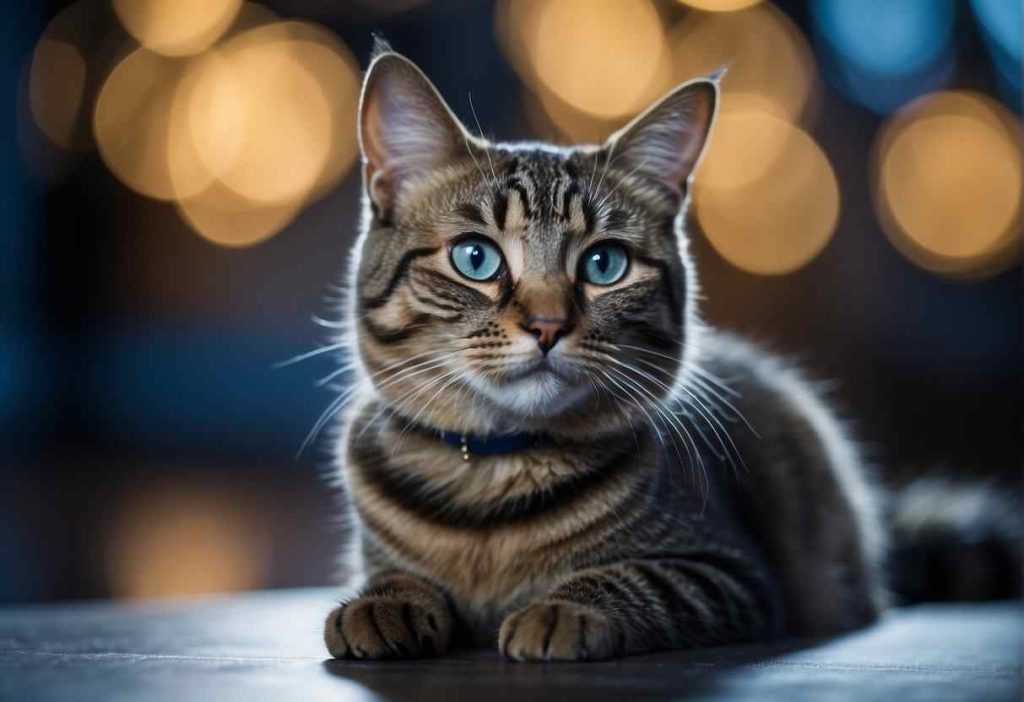
Key Takeaways:
- Does your furry friend seem fascinated by blue light? It’s not their top pick.
- Cats’ eyes are fine-tuned for dusk and dawn hues, not the blue spectrum.
- No, don’t swap all your bulbs just yet. Cats typically respond better to natural light.
What We’ve Learned:
- Those cute cat eyes have their special superpowers.
- They excel in low light, perfect for tracking down that mouse (or toy!).
- Blue light, although trendy, isn’t the cat’s pajamas—for them, at least.
- Your cat won’t be more playful or happier under blue lights.
Guidance for Cat Owners:
- Lighting: Keep it cozy and natural—your cat will thank you.
- Playtime: Use a mix of natural light and their favorite toys—not blue light gadgets.
Future Exploration:
- More studies could unravel the blue light mystery. What exactly do cats see?
- Environmental changes: could different colored lights affect cat behavior? Science, do your thing!
| Checklist | Recommendations |
|---|---|
| Home Lighting | Natural, comforting |
| Cat’s Playtime | Traditional methods |
| Blue Light Gadgets | Avoid relying on them |
Remember, your fuzzy sidekick doesn’t need a colorful light show to be content.
Keep their environment purr-fect with what they adore: a sunny spot to snooze and some good ol’ TLC.
Keep observing and stay curious, you might just discover the next feline frontier!
Frequently Asked Questions
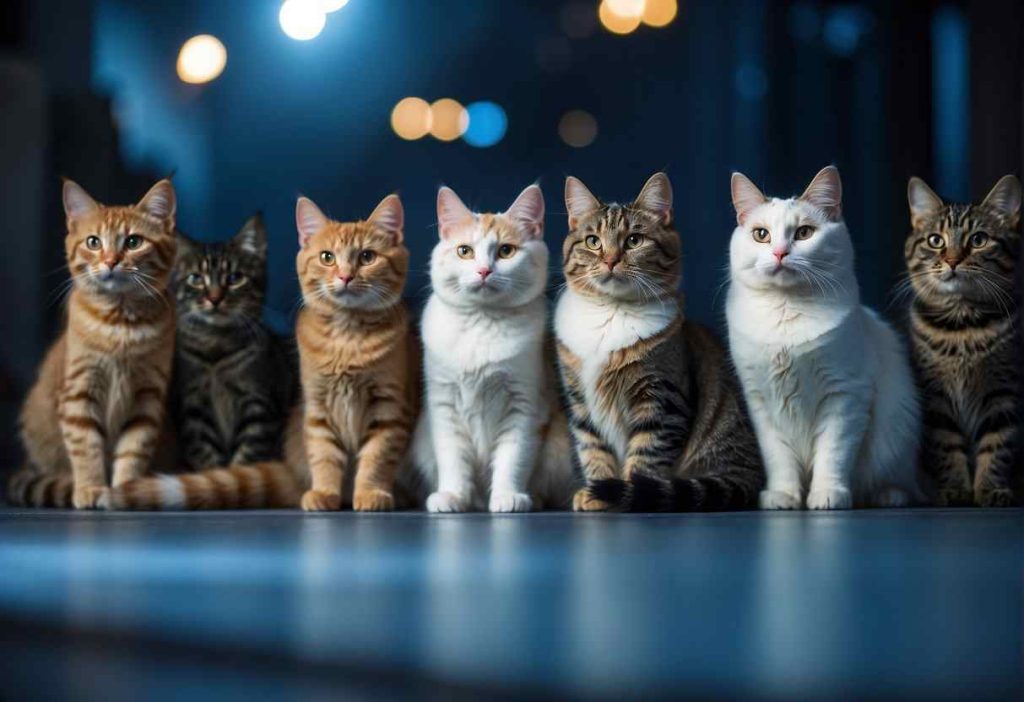
When it comes to your cat and blue light, you probably have a few questions. Let’s look at some specifics around how blue light might affect your furry friend and how you can manage their exposure to it.
Can blue light from screens harm my cat’s eyes?
While there’s no concrete evidence that blue light from screens can harm your cat’s eyes, it’s wise to be cautious.
Just like us, cats can experience eye strain, so it might be a good idea to limit their screen time.
Do cats prefer blue light to natural light?
Cats don’t necessarily prefer blue light; they are generally more attracted to natural light.
Their instincts are attuned to the sun’s cycle, so natural light tends to be better for their overall well-being.
How can I protect my cat from the negative effects of blue light exposure?
You can protect your cat from the potential negative effects of blue light by minimizing their time around screens.
Think about giving them toys and activities away from the TV or computer, especially in the evenings.
What are the signs that blue light is affecting my cat’s behavior or health?
Signs that your cat might be affected by blue light could include changes in their sleep patterns or behavior.
If they seem restless at night or their sleep-wake cycle is off, it might be time to reduce their blue light exposure.
Are certain colors of toys better for my cat’s vision and engagement?
Indeed, cats see certain colors more vividly than others.
They are quite responsive to blues and greens, so toys in these colors could be more engaging for them compared to reds or pinks, which they may perceive as more muted.
Can changing the lighting in my home improve my cat’s mood and health?
Adjusting the lighting in your home to mimic natural light as closely as possible can contribute to a better mood and health for your cat.
Consider using lights that have a color temperature that resembles daylight.
Is there a difference in how cats perceive blue light compared to humans?
Cats do perceive blue light differently than humans. They have a unique vision system that is more sensitive to low-light conditions.
However, the full extent of how blue light affects them compared to us still requires more research.
- The Ultimate Overview to Actual Cash Gambling Establishments - July 1, 2025


